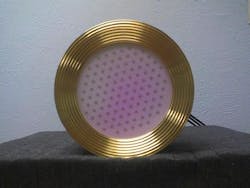MLD supplies coating for SemQuest high-energy laser beam measurement system
Mountain View, CA--Optical coatings manufacturer MLD Technologies has supplied a low-loss "leaky mirror" coating for use in a new fieldable sensor used as a High Energy Laser (HEL) beam diagnostic. This "leaky mirror" disperses most of the incident HEL energy but allows a very small percentage to pass into the diagnostic array. MLD specializes in ALD, IBS, and other optical coating technologies.
This Beam Irradiance on Target System (BITS) is a HEL sensor array that directly measures the beam irradiance profile of HEL weapons. The BITS is a sensor array composed of 105 sensors arranged in a hexagonal pattern over a 10 cm diameter circular area and it is designed to withstand direct exposure to continuous wave (CW) lasers at very high irradiance levels (multi-kilowatt/cm2). The sensor array spatially and temporally samples HEL beam profiles and is the only reusable and direct (on target) measurement system of its type. The BITS represents the state-of-the-art in directed energy test and evaluation sensors for HEL applications.
The system was required to survive the representative multi-kilowatt/cm2 irradiance levels while also offering significant spatial and temporal resolution of the HEL beam profile diagnostics.
BITS was the outcome of a Science and Technology (S&T) project funded by the Program Executive Office for Simulation Training and Instrumentation (PEO STRI). SemQuest acted as the prime contractor for the effort with ITT Advanced Engineering and Sciences as the primary subcontractor. MLD Technologies provided optics consulting and manufactured the coated optics for the sensor array and the Epner Technology laser gold process was used to protect the metal target frame.
In October of 2012 the BITS system underwent its final acceptance test at the High Energy Laser Systems Test Facility (HELSTF) located in the White Sands Missile Range (WSMR) test complex. The BITS system was exposed to over 20 HEL shots using the 20 kW IPG laser at irradiance levels as high as 5 kW/cm2, exposure times of ten seconds, and beam diameters of 2-5.6 cm (1/e2 diameter). The system provided calibrated truth data for the direct measurement of HEL exposure. To date BITS has undergone 74 tests under HEL conditions in outdoor environments, demonstrating that it is indeed a reusable and deployable system.
How it works
The BITS is composed of an array of optical collection cavities that are distributed across the sensor array. The sensor cavities are covered by a coated optics mirror that reflects the majority of the incident HEL light. One important advantage of the BITS is its ability to reflect the incident beam in a divergent pattern. This mitigates potential damage to anything in the path of the reflected energy which is important for the wide variety of test conditions that BITS will be exposed to.
SOURCE: SemQuest and MLD Technologies; contactJohn Le Sage of SemQuest (http://www.semquest.com) for more information about the BITS sensor and Ric Shimshock of MLD (http://www.mldtech.com) for information on low-loss coatings for HEL applications.

Gail Overton | Senior Editor (2004-2020)
Gail has more than 30 years of engineering, marketing, product management, and editorial experience in the photonics and optical communications industry. Before joining the staff at Laser Focus World in 2004, she held many product management and product marketing roles in the fiber-optics industry, most notably at Hughes (El Segundo, CA), GTE Labs (Waltham, MA), Corning (Corning, NY), Photon Kinetics (Beaverton, OR), and Newport Corporation (Irvine, CA). During her marketing career, Gail published articles in WDM Solutions and Sensors magazine and traveled internationally to conduct product and sales training. Gail received her BS degree in physics, with an emphasis in optics, from San Diego State University in San Diego, CA in May 1986.
